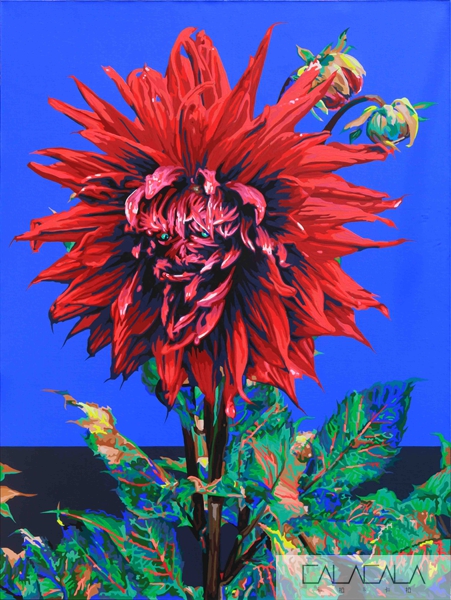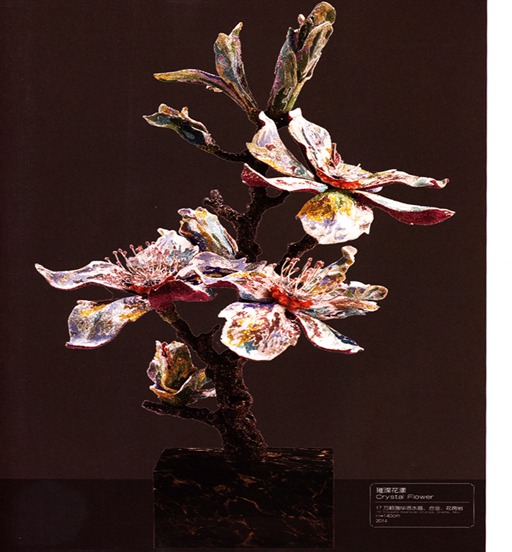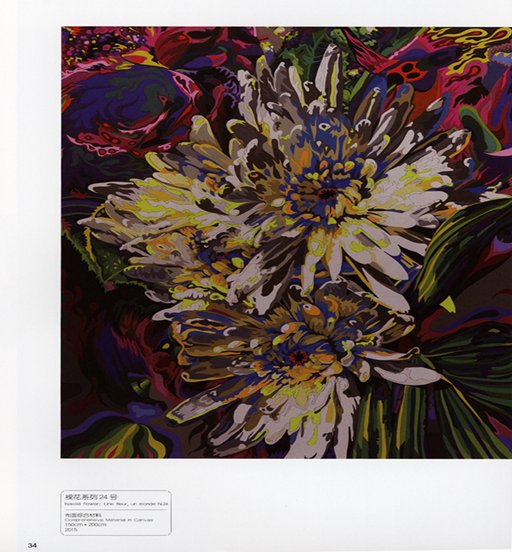2018, Post-Oriental Studies ~ An experiment in the establishment of mutual-vi
Post-Oriental, an experiment in the establishment of mutual-viewing relations---- written in "Art Capital" at the Grand Palais in Paris, France
Written/Wu Hongbin
At an art salon exhibition in Paris in 1742, Francois Boucher, a representative painter of the French Rococo style, exhibited four works with a strong Chinese style, namely "The Emperor of China" and "China "Market", "Chinese Garden" and "Chinese Fishing Scenery", these four works were extremely welcomed and rushed as soon as they were exhibited! Even if Boucher had not been to China in his lifetime, he Still combining his little knowledge of China with French art, he painted an imaginary Eastern country for Europeans. Coincidentally, Jean Auguste Dominique Ingres' "Grande Odalisque" was exhibited at the Paris Art Salon in 1819. This classicist genius will hold a peacock. The beauties of the Near East with feather fans are placed in the Turkish bedroom as a visual representation of their Eastern cognition. The fascination with the “other” in the East has not disappeared because of the end of the colonial movement, and continues to this day in the 21st century.
Why do Fang artists and the general public have a special liking for the East and never get tired of it? According to the post-colonial view, watching may not be an innocent act, but the subject is exercising power over the object, and the self's gaze on the other is often -The establishment of a relationship. Just like Edward Wadie Said mentioned in his book Oriental Studies that the West "sees the East as an ideal and immutable abstraction"! The shaping of images It depends on the geopolitics, power order and local culture's right to speak in the world of the local artist's time. Said discovered with his unique vision the ideological tendencies implied in Oriental studies in the Western world, thus opening the door to post-colonial criticism.
In the late 1980s and early 1990s, as the post-colonial criticism represented by Said’s “Orientalism” was introduced into China, thinking about the concept and relationship between “zhe” and “self” began to frequently appear in contemporary Chinese art criticism. . According to the logic of "Oriental Studies", post-colonial criticism should first reflect and criticize the Western Eastern discourse. The methodological significance of "Orientalism" is first of all to observe the self from the other and reflect on the self-subject status, with a view to constructing a more perfect subject identity in the social and historical field. From today's point of view, simply understanding the concept of "other" as difference in the general sense, or placing too much emphasis on the subordination of the Eastern "other", may fail to see the positive value of "other". When globalization has become a trend of our time, it is particularly necessary for Eastern countries to break out from the predicament of historical "being seen" and "other", and how to establish their own independent cultural identity! In his "Oriental studies", De did not propose a specific method to reconstruct and confirm the identity of Eastern culture, but the cultural enlightenment it brings us can be affirmed! That is, the transcendence of the dualistic conflict between Eastern and Western cultures; the establishment of multiculturalism The new relationship between dialogue and symbiosis, in order to obtain the cultural identity and cultural identity in reconstruction! Habermas also deeply agrees that the rationality of communication should be based on this intersubjectivity!
Today, post-colonial criticism has gone beyond the discussion of the external cultural relations between the West and the East, suzerain states and colonies, developed countries and developing countries, and has extended to the broader and more extensive and broader existence of social strata, gender, ethnic groups, and even the existence of individuals within the society. Complex research field. And should we also go beyond Said's "Oriental", which describes the relationship between the East and the West as a kind of "self" and "other" in the power relationship; transcending the geographical limitation and ideology of the East and the West The simplification of opposition and contradiction brought about by differences; transcending one-way "seeing" and "being seen" to establish a relationship of equality and mutual viewing. In particular, after the turn of "iconology" in the second half of the 20th century, exploring the intersubjectivity of different cultures through the presentation and examination of "self" and "other" in image art is a topic of great research value! In the visual field, there was a need and opportunity for mutual viewing in both Eastern and Western art in the period.
The selection of Chinese participating artists and works is based on this concept and logic. We carefully selected 16 contemporary Chinese artists who are committed to easel painting, and present a kind of existence and ecology of contemporary Chinese painting from the three perspectives of "locality", "subject" and "language". The specific presentation methods are as follows, "Oriental text": Lei Ziren, Li Wang, Xu Songbo, Wang Fei, Lan Yi; "Experiential Narrative": Hua Qing, Luo Qing, Xu Chenyang, Chen Zijun, Yang Yongsheng; "The Dimension of Language": Zhu Mingtao , Ren Jian, Kang Lei, Zhang Siyong, Zhou Song, Mo Han. The "Oriental Text" aims to present the relationship between tradition and the present to the West through introspection: Lei Ziren is committed to the contemporary interpretation of the context of traditional painting; Li Wang focuses on the divergence of traditional literati life and interest; Xu Songbo uses vision Archeological methods construct a spiritual dimension that touches Chinese traditions; Wang Fei uses paintings to write legends of Chinese texts; Lan Yi explores the possibility of activating traditions with the help of modern technological concepts. "Experiential Narrative" opens itself based on the subjective presence of contemporary Chinese artists: Hua Qing's attitude of adhering to art as life calmly presents a sense of daily ritual; Luo Qing's mysticism tends to point directly to Western existentialism and religion Sense; Xu Chenyang greets the depths of self-experience and the surreal world with his original painting method; Chen Zijun explores the possibilities between reality and illusion with female-specific perceptual brushstrokes; Yang Yongsheng uses his unique eyes of experience Examine the classics, examine the self, examine the existence. "Language Dimension" regards the way and status quo of painting's ontological language in China as its horizon: as representatives of image language, both Zhu Mingqiang and Ren Jian chose the motif of landscape. Zhu Mingqiang combined contemporary images with oriental aesthetics; Ren Jian Ze directly connects traditional Chinese Taoist concepts with Western modern formalism; as a representative of expression language, Kang Lei is committed to combing the context of modernist painting and effectively blending self-expression with form and performance; Zhang Siyong will Abstract purity is used as the noumenon to explore the counterpoint relationship between spirit and image; as a representative of contemporary realism language, Zhou Song explores the fit between visual reality and conceptual reality; implicitly considers the relationship between image and history. These 16 artists will take an active role in the 2017 French Grand Palais Art Fortune Salon to present a look of current Chinese painting and the various reasons behind this look. Compared with European artists since the 18th century Wishful thinking of Eastern meditation, what kind of similar space will they bring to the "gazers"? At the same time, as the "gazers", what kind of other world will we see? We] hope that through this exhibition, the artists and their works will be visualized The experimental method of relationship building explores the following three questions: 1. The misunderstanding and misunderstanding caused by the difference in the degree of "knowing the enemy" and the distance between the self and the other; 2. The information conveyed by the artwork and Resonance or incomprehension of the technical means adopted when facing the gaze of others. 3. The possibility and degree of cultural unconsciousness and the geopolitics and ideology of the self and the other influence the judgment.
Thank you very much for the invitation of Mr. Paul Alexi, Chairman of the French Contrast Salon, and the collaboration of the Contrast Salon art consultant Jin Zhenchen. The meticulous organization and planning of Beijing Millennium Time Gallery! I would like to express my sincere tribute to the two major art institutions that have vigorously promoted the development of modern and contemporary art and academic development in China! The annual "Art Captal" will set the opening date of this time It’s February 14th-this is the most romantic day in the eyes of Westerners! I don’t know if it is the intention of the French organizers or a romantic encounter? But I believe that in a warm atmosphere is the most suitable for each other to see each other carefully. See you in Paris on Valentine's Day 2017!
Wu Hongbin at Renmin University of China
Christmas 2016
(Wu Hongbin, critic, curator, associate professor and master's supervisor of the School of Art, Renmin University of China)
To Chinese Artists
[French] Lydia Arampur
In February 2017, Mr. Zhang Siyong of Beijing Hanwei International Art Center led 16 Chinese painters to participate in the Art Fortune Salon exhibition held at the Grand Palais in Paris.
The first conclusion I got from my observations is: every painter participating in this exhibition has mastered superb painting techniques, which is an indispensable talent for creating and expressing works. Many of them are already well-known painters, have participated in many exhibitions, and their works have become more mature. Among them, some painters are still teaching in universities while pursuing their own artistic development, imparting their experience and profound knowledge. The second conclusion I have drawn from observation is: Although a variety of expression methods are the guarantee of showing their individuality, they never follow a certain genre against their will at any time, which allows them to display their true artistic talents. In addition, I can really feel that they are committed to deepening their artistic attainments and constantly exploring in their daily rigorous work to pursue new development.
The following are my personal thoughts on each painter's work. I hope this is the closest true portrayal to the facts.Most painters use concrete methods to depict the world they live in. The art of painting has a history of thousands of years, and at the beginning it served religion. Contemporary painters are already very familiar with pen techniques and incorporate them into modern thoughts.
The lines of Lei Ziren's characters are slender and exquisitely colored. His paintings are full of poetic narrative, and show respect for tradition by injecting new vitality into the enduring tradition.
Li Wang prefers to convey humor, his composition is unique and very attractive. The theme often quotes from the Chinese traditional animal fables and combines them ingeniously.
Lanyi's utopian landscape appropriately reproduces the traditional Tang and Song dynasties. He painted heavier and heavier colors on the paintings, and the original pictures are embedded in them and still retain the original charm.
In recent decades, oil painting has been taught in Chinese art academies, and China, one of the ancient civilizations, has ushered in a new way of painting. Although oil painting started late in China, it has been well understood and applied. The color palette and acrylic used in oil paintings have changed the traditional painting methods and injected new vitality into the traditional Chinese painting thoughts that focused on inner ideas and philosophical thinking from the beginning. At the same time, when painters realize their role in today's society, they also shoulder the obligation to awaken the public's conscience. Oil painting and abstract art allow them to find a new way. Using oil paintings to record and express their personal space has made these painters pioneers and disseminators in this field.
Thanks to his proficient oil painting technique, Xu Songbo follows the realism style of European classical traditional painting art. The scenes of riding the earth and hunting in his paintings are vivid and amazing.
However, Wang Fei has a very different style from Xu Songbo. He uses pure blue to depict symbolic historical dreams, and a gentle face like a woman emerges from the undulating waves.
In addition-some painters born in the 1970s seem to have set the goal of repainting European classicism oil paintings. Yang Yongsheng publicly confessed his inspiration for painting. He repainted Angel's "Wapingsong's Bathing Girl" and David's Horse. "Death of Pull", but it has a different composition from the original and amazingly transparent and professional processing of light tones, which makes the picture a special feeling and avoids mediocre plagiarism.
Luo Qing‘’s strange fantasy makes people gradually feel mysterious, scared and weird. The brushwork of juxtaposed midtones reveals his outstanding and confident painting skills. He explores in the monotone like a mystery and makes it perfect to dominate the dimness. The scene of Adsale banquet.
Xu Chenyang imagines and presents a dreamlike picture. He is closer to the surrealist style. He uses delicate techniques to make not only the imaginary cosmic objects, but also the interstellar space and blank spaces look very strange. Gazing at Zhou Song's abstract world will make people feel a moving beauty, a sense of mystery surrounding the objects he paints. He used strong realism to change and obscure the identity of the object, which is confusing, but his superb painting technique, especially the dizzying and distorted technique, quickly dispelled people's confusion.
Ren Jian lyrically draws the scenery of his hometown with oil paintings, expressing a faint nostalgia, and the hazy light echoes the eternal time of the past.
The color palette oil in Mo Han’s hands also seems to be very sensual, adding a sexy beauty to his oil paintings. He uses precise sketches and paints that make the paintings look lively and lively to place the young Chinese women in the paintings. Surprising location.
Hua Qing's expressive realism wanders between ridicule and sarcasm. In order to achieve a strong contrast effect, the pigments he paints become heavier and richer in order to imitate the best phantom effect. His color expression occupies a priority and dominant position in the narrative expressing dissatisfaction with the status quo.
Other painters choose to create oil paintings with dark vision and allusive meaning, and the objects in the paintings are looming. Chen Zijun has the unique sensitivity of an artist. She skillfully swayed the brush, under which the transparent paint flows like a tulle, forming the outline of a person. The color of the base of the oil painting is sometimes blurred and sometimes clear. Therefore, one is optional. There are some imprints of fluidity that may not be true in the space of, allowing the viewer to guess the image of those characters. There are also painters who choose to change the traditional materials and techniques to create, and Kang Lei chooses to use Tempera Tempera to create. This is a popular painting method in the Middle Ages and the Renaissance, which involves mixing eggs with paints to paint. She chose a very rich material, so the picture is very shiny. She first used blue and green colors, and then added cadmium and ocher colors to present a picture of various plants intertwined together. Twigs make up the trunk, and the trunks are then combined into everything. The colorful gardens and small bushes present a prosperous scene. In addition, the appearance of cacti on the screen makes people feel threatened.
Nature also inspired Zhu Mingqiang. The natural landscape under his vision is divided into uniform tones and monochromatic lines, but he never indulges in abstraction. He painted the natural scenery in a "post-impressionist style"-one color is green.
Painter Zhang Siyong, who is also the curator of this exhibition, is committed to exploring new horizons. He perfectly integrates traditional and modern, Eastern and Western painting art, making the lyrical abstract art of French and Western painters compatible with Chinese traditions. The art of calligraphy resonates and responds. His self-contained language brings together symbols based on his philosophical knowledge in order to approach the essence of the universe. His paintings are fast and good, responding to the vitality and vitality of nature. He surprisingly improvised and squirted the ink, making it form continuous loops or curved lines and irregular nets, in line with the rhythm of the universe and synchronization. When the raging colors engulf the space, it will form a sharp contrast with the white space of the picture. Imprints, markings, and curves work together to compose a score that can develop infinitely.
The creations of these artists have, in a sense, a certain value of artistic literature.
Artists have crossed national boundaries and forged friendship through art that promotes the spirit of humanism.
Lydia Arampur
Art historian, critic
Fellow of the French Academy of Arts, Painting Communications, February 2017, Paris



